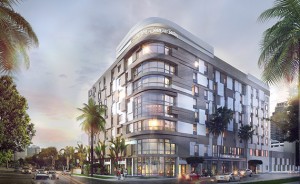Ezra Katz has handled multi-million dollar transactions in South Florida, ranging from the Fontainebleau Hotel financing (twice) to portfolios of office buildings in Miami-Dade and Broward counties.
Katz, the founder and CEO of the Aztec Group and Mayan Properties, sat down with The Real Deal as his company announced its most recent deal, the sale of a downtown Miami building to Aria Development, the same group building a Yotel hotel nearby.
What kind of properties do you invest in?
Hotels, shopping centers, apartments and office buildings, predominantly. We buttress that with land investments and industrial, self-storage. You name it, we’ve touched it. We aren’t in the investment game to hold for multi-generational periods. We really had a fairly sizable concentration in office buildings and hotels.
How have the Aztec Group and Mayan Properties grown since you started in 1981?
At that time, it was purely a fee-earning company. I didn’t start the Mayan side of the business until a little over 20 years ago. Mayan was conceived from the very beginning as an investment strategy to create partnerships and to diversify — not only in property types, but also geographically.
Today, my focus is oriented more toward investments on the principals’ side (Mayan Properties), although I do still love the deal-making side (Aztec Group). Having spent well over 30 years on the Aztec side, and having had somewhat of a successful run, it forces me to invest our capital. It’s a very challenging environment, particularly in South Florida, which is why we’ve invested outside of Florida.
How did the recession affect your business?
[vision_pullquote style=”3″ align=””] “We felt uncomfortable with the economy; we felt uncomfortable with the fundamentals.” [/vision_pullquote]We managed to sell hotels and office buildings in the mid-2000s. Luckily, that turned out to be a good decision because of the recession. I would probably attribute that to a lot of good luck rather than having foreseen the recession, but it was consistent with our strategy of looking at properties, adding value to them, and being disciplined enough to commit to an investment and get out of an investment when we’ve essentially obtained a value we felt was reasonable and sell. We stuck to that.
We pretty much sat out between 2009 and 2011 for no other reason than we were confused. It was a very difficult time to make a decision. We felt uncomfortable with the economy; we felt uncomfortable with the fundamentals.
I don’t believe in making predictions when predictions are unpredictable. A lot of people took risks in 2009, 2010, 2011 and were rewarded for it. I did not feel it was appropriate to take my money, and that of my partners, and risk it in those years. However, we did make some investments in those years, but we were extremely liquid. We built and opened the Renaissance Hotel in Raleigh, North Carolina, in January 2009, arguably the worst year you could probably open a hotel. They not only did great the first year, but they paid debt service and distributed money, which was unthinkable.
We could have done a lot more. And, we have no regrets.

Rendering of a Hampton Inn in Midtown Miami that Katz is building
What are some high-profile transactions that stand out over the years?
I guess, the Fontainebleau is memorable. I financed it twice — $100 million each time. Ultimately, I worked with the owner to sell it to the current owner. It represents over 15 years of activity. We did the Mayfair in Coconut Grove transaction twice.
In my initial years of business in the early 1980s, I sold 13 high-rise apartment buildings in one transaction, which at that time was the largest transaction ($142 million) in Florida, in Miami and Broward County. It kind of put me on the map.
We represented Craig Robins and sold his Lincoln Road portfolio to Terranova. That was a really challenging, but very creative transaction.
There’s a lot of optimism about the South Florida market right now. Do you agree?
I think it’s the most difficult question of all to deal with. I’ll tell you this: I’m absolutely optimistic about South Florida. Does that translate into the concept that everything’s going to continue to be good and grow? Are prices going to continue to increase? We’re inevitably reaching some sort of plateau. There are a lot of residential units in the high-rise condo market. The word that needs to be put out there is discipline by developers and bankers. But I’m optimistic about the future of Miami. I love that young people are coming here. My kids love it here. I never thought they would come back to Miami. I think those are good indicators.
What are your plans for 2015?
We’ll continue to diversify our investment base from a property, conceptual and geographical point of view. We hope to invest as much as $200 million this year — at least 50 percent will be in hotels and office buildings. Shopping centers will probably eat up 20 to 25 percent of the capital.
[vision_pullquote style=”3″ align=””] “I talk to the market. I love listening to what’s going on in the marketplace.” [/vision_pullquote]What’s a typical day like for you?
There’s no typical day, which is why I like doing what I do. I talk to the market. I love listening to what’s going on in the marketplace. We’re in the real estate business and that’s all we do. We don’t understand anything else.
What do you think about the resurgence of Coconut Grove?
I love it. I lived in the Grove 30 years ago. I got married in the Grove. My wife and I always said we’re going to move back when we’re old, and we are going to move back at the end of this year. We got a unit on the 18th floor in the Grove at Grand Bay [next-door]. I’m going to zipline to work.
This interview has been edited and condensed for clarity.
